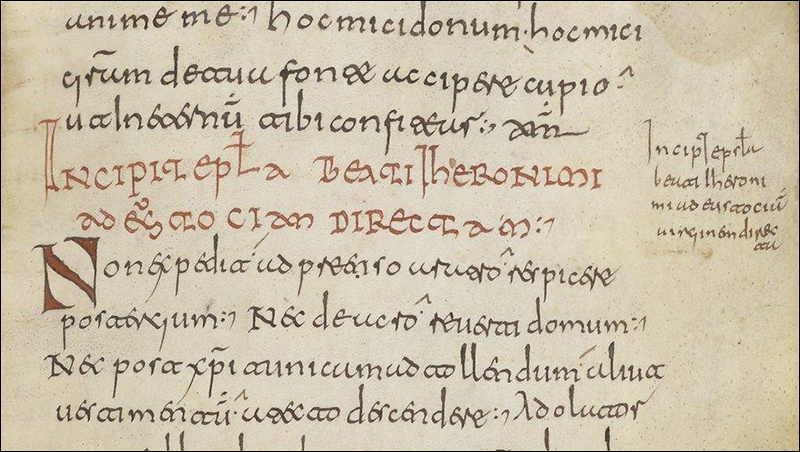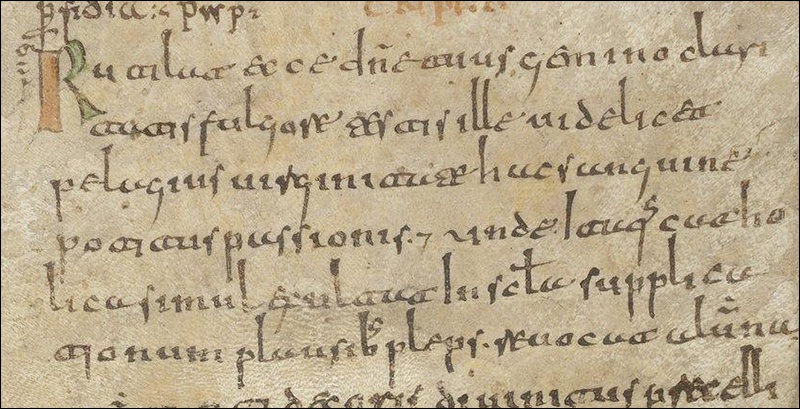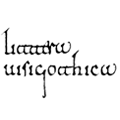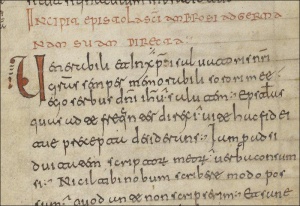Codex of the month (VI): Paris, BN, NAL 239
Paris, Bibliothèque Nationale, nouv. acq. lat. 239 > Regula sancti Leandri et Flores sanctorum > dated 10th + 11th century.
The codex chosen this month is very different from the previous ones. It was not made to inspire fear and teach through its astonishing program of miniatures as the Beatos, nor has it ornamentation or curious decorated initials to talk about as the Leonese Antiphonarium mozarabicum or the John Rylands’ Moralia. This codex was copied only because it was necessary for the pious practice of its owner; there was no need for an excruciating slow writing, the most skilled scribe, or the finest parchment available. Codex Paris, BN, NAL 239 is a monastic book, one that transmits, among other similar texts, the Regula of Leander of Seville, Isidore’s brother, as he composed it for his sister, Saint Florentina, nun and founder of a long list of monasteries in 6th-century Hispania.
I. CONTENTS:
This book is formed by two distinct parts that were already together at an early time.
 © Paris, BN, NAL 239, fol. 26r. Detail of incipit (Epistola beati Iheronimi).
© Paris, BN, NAL 239, fol. 26r. Detail of incipit (Epistola beati Iheronimi).
A) The first part, fol. 1r-67v – lacking some of its initial and final folia –, gathers different monastic texts from the 4th, 5th and 6th centuries, useful for a female community: fol. 1-10 Saint Leander of Seville’s Regula (fragment) (PL 72 0873); fol. 10-23 Saint Ambrose’s De lapsu uirginis (CC); fol. 26-30, epistola beati Iheronimi ad Eustociam directam (de custodia uirginitatis, 22); fol. 30v-38, epistola sancti Ambrosi ad germanam suam directa; fol. 33v-38, epistola Euacri ad uirginem directam; fol. 38-42, epistola beati Iheronimi ad quondam uirginem. To these corpus of texts follows what seems to be two letters about computus (on the dates of Eastern in relation to the Jewish celebration), dated 764, between some Petrus and the bishop of Cordoba Félix (fol. 42v-43v-47v), and the Vita uel transitus beatissime sancta Seculine (Ségolène de Troclar) (fol. 47v-67v).
 © Paris, BN, NAL 239, fol. 74r. Detail of incipit (Saint Pelagius).
© Paris, BN, NAL 239, fol. 74r. Detail of incipit (Saint Pelagius).
B) The second part, fol. 68-83 – lacking a bifolium between fol. 74 and 75 (being, currently, one fol. 82) –, presents the liturgy of Saint Pelagius of Córdoba (10th century), including his Passio (fol. 74). It still has the first folio, 68r, blank.
II. PHYSICAL DESCRIPTION:
Support: Besides lacking some gatherings and some damage in the internal folia that were used as flyleaves, it is a well-preserved codex. The parchment used to copy part B is of less quality, thick and rough. Modern binding of brown leather.
No. of leaves & layout (more on codicology of Visigothic script codices here):
A) 67 fol. (255 x 150 mm); single column; quaternions; pricking and ruling (in dry point) varies:
 © Paris, BN, NAL 239, fol. 8r. Detail of pricking and ruling part A.
© Paris, BN, NAL 239, fol. 8r. Detail of pricking and ruling part A.
The pricking and ruling are not the same in all the gatherings. Thus, fol. 1-22 were ruled with a vertical line in the left side, pricking in the upper and bottom margins, and two vertical lines in the right side, with only the second one pricked. The horizontal lines, 22 for fol. 1-14 and 17 for fol. 15-22, were pricked on both sides, although only that done in the outer margin can be clearly seen. These lines go across all the page, irregularly, surpassing the vertical lines by both sides. The interlinear space, vertical and horizontal, varies for each quaternion. The scribe did not copy text on the last of the horizontal lines. And also the text was sometimes continued after the vertical lines, altogether making an irregular text box, only justified by the left margin. On the other hand, fols. 23-67 were ruled with only one vertical line each side of the writing box while the horizontal lines of this group go from 20 for fol. 23-45 to 21 for fol. 46-67 – with text on the last horizontal too.
 © Paris, BN, NAL 239, fol. 30v-31r. Detail of catchwords part A (conuersa).
© Paris, BN, NAL 239, fol. 30v-31r. Detail of catchwords part A (conuersa).
Although some of the first quaternions have lost folia, catchwords, linking a gathering with its next one, can still be found on fol. 14v, 22v, 30v, 37v and 45v.
B) 16 fols. (255 x 150 mm); 18-lines, single column; bifolia; pricking and ruling (in dry point) done for both vertical (one for each side) and horizontal lines (pricked in the outer margin). The interlinear space results, again, irregular. Neither signatures nor catchwords were used to help organise the gatherings.
Copyist/s and scripts:
One scribe, who for Díaz y Díaz subscribed on fol. 47v, copied part A in a Visigothic minuscule script with cursive influence. The same hand wrote down on the outer margins the texts to be rubricated in Half-Uncial script with the openings of each of the works copied. This scribe has been dated by Díaz y Díaz as from the 10th century.
Benedictus es domine quoniam adiuuisti me et consolatus es me. O uos qui legeritis me indignum miserum et nimis peccatorum meorum catenis abstrictum nec nominandum Uiliulfum imperitum in uestra digna memoriam reducite precantes pro delictis meis domini misericordia, si uos ille Iesus meus introducat in caelorum patria gloriosa, amen. (Fol. 47v)
•tweet it
Two scribes copied part B (one fol. 68-75v, 83; the other fol. 75v-81, 83) using different types of black ink, in Visigothic minuscule script. These scribes have been dated by Díaz y Díaz as from the 11th century.
 © Paris, BN, NAL 239, fol. 70r. Folio part B.
© Paris, BN, NAL 239, fol. 70r. Folio part B.
None of the three scribes shows a calligraphic script, but rather rudimentary skills in writing meaning that the text was not carefully written as in other lavishly made codices to be treasured. This codex just required to be useful. Thus, the script needed to be easy to read, the text easy to follow. No flourishes were used because none were necessary.
Illuminator/s: There are no miniatures in any of the two parts of the codex. Only some simple initials in red (part A) and red and green (part B).
III. HISTORY:
Origin: While for Millares this codex should have been made in a Mozarabic centre considering its content, Díaz y Díaz ascribes it to Castilia; moreover, to a Castilian centre nearby Aragon. Bearing in mind the first part of the codex, it was clearly made for a female monastic community. Considering the second part, it must have been written in or for a monastery consecrated to San Pelayo. It has been proposed the women’s monastery of San Pelayo, near Salas de los Infantes (Burgos), as its production centre, although it could have been copied in any other pelagian cenobium nearby Silos.
Provenance: Santo Domingo de Silos; it seems that this codex was in the monastery’s archive in the 18th century as included on its catalogue.
Context: There are only two other extant codices with Leander’s Regula, also in Visigothic script: the so-called Codex of Leodegundia (El Escorial, Biblioteca del Monasterio, a.I.13, 11th century), and the Emilianensis 53 (Madrid, Real Academia de la Historia, Emilianense 53, 11th century; digitised). No other copies of Saint Ambrose’s De lapsu uirginis or the Vita sancta Seculine.
IV. References:
- C. U. Clark, Collectanea Hispanica, Paris 1920, 53, nº 660. (online)
- L. Delisle, Mélanges de Paléographie et de Bibliographie, Paris 1880, 76-78. (online)
- M. C. Díaz y Díaz, Códices visigóticos de la monarquía leonesa, León 1983, 448-451, nº 183 and 184.
- A. Millares Carlo, Corpus de códices visigóticos, Las Palmas de Gran Canaria 1999, nº 255.
>>> Digitised (BnF Gallica) <<<
by A. Castro
[edited 12/07/2018]

